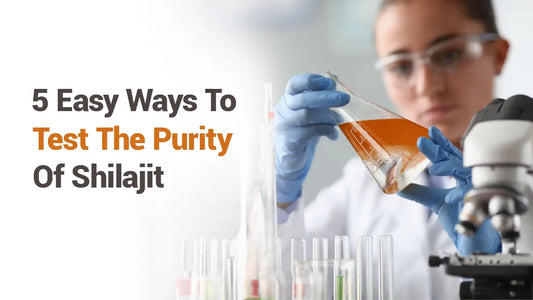Aug 06, 2025
Shilajit is a supplement from nature, any kind of its adulteration does not justify the purpose it's meant to serve. Though the sellers in the market are supposed to be credible sources of pure, high-quality shilajit, this doesn’t happen often- the result- customers don't get the expected benefits.
There are ways to recognize a high-grade shilajit, some of which require a proper laboratory setting while simple ones do exist that can be done at home. Here, we will list five commonly used, easy home methods that will be helpful in recognizing pure shilajit.
Shilajit Origin
The formation of shilajit is limited to altitudes >2000m where the soils and plants specific to this region are decomposed by microbes here. The original shilaljit extract hence can have impurities from the soil and the surrounding environment of the region.
Pure Shilajit
The so-formed shilajit in nature hence can not be expected to be pure and needs to go through several purification steps. Once all the impurities attached to it are completely removed via purity processing, shilajit becomes ready to be consumed.
Impure Shilajit
The shilajit may not be pure if it is not well purified and also, if it has been tampered with while synthesizing the resin. Lets understand what makes shilajit impure and non authentic.
-
Soil and dust particles: In general, the source of soil and dust particles is the environment in which shilajit gets formed. However, some sellers may leave it without further processing as it can increase more cost.
-
Heavy metals: The beneficial 85+ metals that shilajit is praised for are essential ones required in our body. However, freshly harvested Shilajit in the raw form contains more numbers of minerals than that. Heavy metals like Lead, Arsenic, Mercury, Cadmium are found in the raw form, if unprocessed these elements can be toxic to the body.
-
Fillers and adulterants: As all sellers are not committed to providing shilajit at its best natural form, some shilajit in the market may be intentionally adulterated with extra ingredients just for producing bulk volumes. Some common such adulterants involve mixing of Coffee and burnt sugar to increase the volume. Also, soil/clay, charcoal, ash, resins resembling shilajit and artificial colors are found in fake shilajit products

How To Test Purity Of Shilajit?

The purity of Shilajit can be tested by ayurvedic standards at home which involves following tests:
-
Solubility Test
Just a simple testament and you get to analyze the purity of shilajit- watch how miscible it is in warm water. The focus here is to watch if the residue of impurities settles at the bottom of the glass. Follow these steps:
- Take a transparent glass and add around 200-400 ml of hot warm water in it
- Take a small scoot somewhat between pea-sized amount of Shilajit and put it in the glass containing hot water
Some companies have refined it so well that as soon as it touches hot water, it slowly starts to melt. If not, take a spoon and stir till the solution containing pea sized shilajit dissolves completely. Observe if any residues settle at the bottom.
If residues remain or residues settle at the button: It means shilajit has impurities.
If the solution is clear or doesn’t: It's an indication of pure, authentic shilajit.
-
Strand Test
Similar to the solubility test, this test involves observing the way shilajit resin dissolves in water.
The steps are simple
-
On the above test just observe the way Shilajit dissolves
-
Check if the shilajit dissolves with continuous strands or not.
If slow or fast dissolving strands are visible consider the Shilajit is pure and authentic.
If shilajit dissolves without strands: The shilajit you have tested does not possess qualities of an authentic shilajit.
Moreover, both the solubility and strand test together can be used to confirm the purity of shilajit.
-
Flame Test
Though there are fewer supplements that we put through tests like this, the flame test is one of a kind to know the purity of shilajit.
- Take a stainless spoon and put pea-sized shilajit on it.
- Expose the spoon to fire, take help of a lighter.
If it catches fire instantly: It's impure shilajit.
If it takes time to burn/ slowly turns into ashes: It's pure shilajit.
-
Pliability Test
This test is to check how flexible the shilajit is Pure shilajit is said to be totally soft at warm temperature.
- Take shilajit’s pea-sized amount in your hand, knead it between your hands.
If it stretches: It’s pure and authentic shilajit.
If it breaks and is brittle: It’s not a sign of pure shilajit.
You can even freeze the shilajit and then apply this test. Any shilajit would become firm/ hard after certain hours. If it becomes pliable without breaking due to the warmth, then it is surely pure shilajit.
-
Key Visual Indicators Test
Ayurvedic standards mention that pure Shilajit Nepal should have “Krishnawarna” appearance, meaning it should be the color of Krishna which is slightly black or dark color.
Other visual indicators to test the purity of shilajit can be its resinous form, glossy appearance and sticky texture at room temperature.
You can also rely on the smell test additionally, the Ayurvedic standard for this is “gomutra”- like smell (smell like urine of cow).
Read Recommended : Where to buy shilajit near me
How To Avoid Impure Shilajit?
There are certain simple guidelines that’ll help you avoid impure shilajit prior to buying. For this, buyers should focus on asking the sellers for: sourcing information, third-party purity testing certificate and the composition of their final product.
At Everest Shilajit, we provide you with the following purity indicators:
-
Heavy metal content
-
Microbial contamination
-
Ash/ Moisture content
-
Transparent final product composition
-
Authentic sourcing information
-
COA on demand
Recommended Read: Can Shilajit Help Increase Sperm Count?
FAQs
Q. How to check purity shilajit?
A. From seller's side, you can access the purity certificates. You can also perform the following tests at home: solubility, strand, flame, pliability and key visual parameters tests.
Q. How to get the purest form of shilajit?
A. The most effective method of getting the purest form of shilajit is to identify a trusted seller with an authentic source of origin, positive customer feedbacks and third party tested certificates.
Q. Which shilajit is 100% pure?
A. Legitimate sellers such as Everest Shilajit give you the purest form of shilajit.
Q. How does pure shilajit smell?
A. Pure shilajit has an identical smell to that of Cow’s Urine.
Q. How to store shilajit resin?
A. Keep in an airtight container in a cool, dark, dry place (like a cupboard). Refrigeration can extend shelf life and prevent softening.
Q. Does shilajit expire?
A. Yes, it has a shelf life. Purified resin/extracts typically last 1-2 years when stored properly in a cool and dark place. Check the product expiry date.
Q. How to identify pure shilajit?
A. Look for: Solubility (dissolves completely in warm water leaving minimal residue), Purity Testing (CoA from seller), Taste (strong, bitter, tar-like), Texture (resin should soften with heat) and Burn Test (pure resin gradually forms ash -use caution). Source from reputable suppliers.
Q. How to test shilajit at home?
A. Solubility test (dissolves in warm water), Burn test (does not burn instantly, gradually forms ashes), Water test (pure resin dissolves totally). These are indicators, not guarantees; lab testing (CoA) is best.
Q. What is better, shilajit or ashwagandha?
A. They serve different purposes. Shilajit is mineral-rich, boosts energy & vitality, supports testosterone. Ashwagandha is an adaptogen for stress relief, anxiety, and cortisol balance. They can be complementary.
References:
Written By:

Authentic Shilajit sourced from the Himalayas of Nepal
Everest Shilajit is a premium wellness brand founded by Pragya Mahara, offering authentic Himalayan Shilajit resin sourced at high altitudes. With over a decade of global business experience, Everest Shilajit blends ancient Ayurvedic tradition with modern quality standards to deliver pure, lab-tested Shilajit worldwide.
Disclaimer
The content provided in this blog is for informational and educational purposes only. It is not intended to be a substitute for professional medical advice, diagnosis, or treatment.








